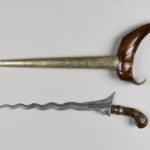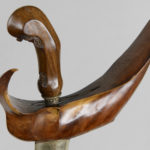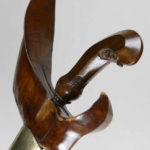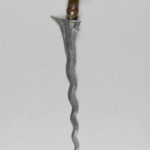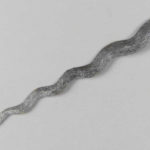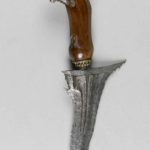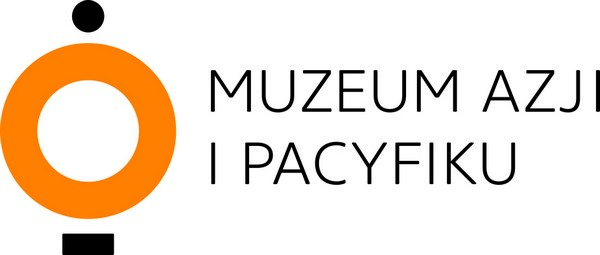Keris inv. № MAP 1
Indonesia, Central Java, Surakarta (Solo), 19th century
entire length including the sheath: 48,3 cm; entire length: 43 cm; blade length: 34,8 cm
iron, nickel, steel, wood, paktong, copper
forging, damascening, etching, carving, lacquering, engraving
On 26 February 1973, Andrzej Wawrzyniak donated his collection of Indonesian arts and crafts, comprising above 3000 items, to the Polish state. The collection gave rise to the Nusantara Archipelago Museum, a few years later transformed into the Asia and Pacific Museum (MAP).
The inventory registers of the Museum start with this very item from the collection—it is an Indonesian national keris dagger from Java given the identification number “MAP 1”.
For more than a hundred years, such daggers had ceased to function as weapons, being ceremonial and ritual objects instead as well as symbols of status and amulets. They were part of a family’s heritage, transferred from father to son. Kerises have a double-edged, asymmetrical blade decorated with a bright (nickel-including) pamor pattern considered to have magical properties and looking like veins of timber. Meteorite iron was also sometimes used for the production of a keris. The blades are either straight or wavy, with an odd number of waves (bays, luk)—in this example we have 13. The straight blade symbolizes a serpent at rest, the wavy one—a serpent in motion. The serpent’s position in Indonesian imaginary is crucial as it is the mythical ruler of water and the underworld as well as one of the symbols of royalty.
The wooden hilt takes a sophisticated shape referred to as nunggak semi or “budding tree trunk”. It stands for an ancestor, although simplified and radically stylized according to the Islamic ban on figural representations in art.
Furthermore, the keris sheaths forms are specific in terms of their transverse crosspiece called the wrangka. The crosspieces may differ considerably and here we can see a rather fanciful type that may be used on festive occasions.

![grafika z tekstem [journeys to the east]](https://www.muzeumazji.pl/maip/uploads/2022/08/baner_strona_english_tn-1140x220.jpg)

